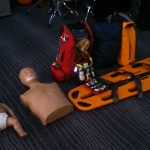Last weekend, this writer attended a Disaster Preparedness for the Family Seminar at the South City Central School in Parañaque City, conducted by members of SARUF (Search and Rescue Unit Foundation, Inc.)
The main speaker was the founding President of SARUF, Jerry Carual. He also served as Director IV under the Office of the President in Malacanang from 2001 to 2010, and boasts of numerous credentials, certifications (both from here and abroad,) and awards including three Bronze Cross Medals from the Philippine Army for risking his life during disasters.

Carual states that to secure your family during disasters, you must first secure yourselves. To accomplish this, one must have the right attitude and mental toughness. Individual preparedness before disasters include: 1) Defining disaster potential, 2) Staying informed, 3) Acquiring training, 4) Developing a plan (weighing, for example, if your family is better off staying in place or do you evacuate?)
In the event of evacuation, it is vital to prepare a family go-bag. A child’s go-bag may contain the following items essential to survival such as: 1) a helmet (protection from falling debris. Also frees the child’s hands for movement, instead of using his hands for cover,) 2) goggles (to see clearly if encountering dust and smoke,) 3) dust mask, 4) thermal blanket, 5) flashlight, 6) whistle, 7) food, and 8) water.

An adult’s everyday carry kit, on the other hand, may contain: 1) a wallet and call cards contained in a water-proof case, 2) a Swiss knife, 3) rope, 4) signaling devices such as a flashlight or a laser light, a whistle, and/or a mirror. These should be put in a dry bag or waterproof bag. Carual emphasizes that survival is directly proportional to preparation. Meaning that if you prepare supplies for one day, you only survive for one day; if you prepare for three days, you survive for three days; and so on and so forth.

Carual was quick to stress, however, that there are different kinds of disaster go-bags for there are different kinds of eventualities depending on the situation you are facing. Aside from the everyday carry kit, there is also a 72-Hour Disaster Kit packed with essentials that will take you from point A to point B. And an Inch Bag, or what he calls the “I’m not coming home” bag, for when you have to leave the area and have no more plans of coming back.
Part 2 of the series, common mistakes and disaster tips can be read here.




One Comment